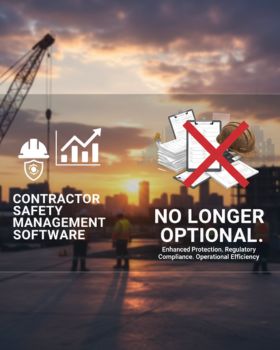
Contractor safety is a critical aspect of workplace safety that often goes overlooked. Dangerous attitudes such as, “Safety is just common sense,” or, “Accidents are just part of the job,” can lead to preventable tragedies. In 2022, the US Bureau of Labor Statistics reported 5,486 workplace fatalities—a stark reminder that complacency is not an option.
Whether you manage a construction site, manufacturing plant, or any environment involving contractors, an effective contractor management strategy is key to minimizing risks and ensuring compliance with safety standards. Let’s explore the importance of contractor management and how leveraging modern solutions, such as contractor management software, can make a tangible difference.
The High Stakes of Contractor Safety
When contractor safety measures are inadequate, the consequences can be severe. Beyond the human cost of workplace accidents, organizations face legal liabilities, reputational damage, and financial losses. Addressing this challenge requires a shift from reactive measures to proactive contractor safety practices.
Three critical aspects demand attention:
- Proper Vetting and Qualification of Contractors
- Ongoing Monitoring and Management of Safety Compliance
- Continuous Improvement Through Data Analysis and Feedback
- Proper Vetting and Qualification of Contractors
Contractors bring diverse skills and expertise to your projects, but their safety standards can vary. Vetting contractors thoroughly before they step on-site is crucial. This includes verifying qualifications, certifications, and previous safety records.
Key steps include:
- Conducting background checks on contractors and their work history.
- Ensuring contractors are certified to handle specific tasks and equipment.
- Reviewing past incident reports, if any, to identify potential risks.
A robust contractor management system simplifies this vetting process by centralizing contractor data, making it easier to assess qualifications and maintain detailed records.
- Ongoing Monitoring and Management of Safety Compliance
The responsibility for contractor safety doesn’t end once they’ve been hired. Active monitoring ensures contractors adhere to safety protocols throughout the project. This includes regular site inspections, real-time compliance checks, and immediate corrective actions when violations occur.
Tools such as contractor management software provide real-time updates on safety performance. Features like automated alerts for training renewals and compliance deadlines keep safety measures on track. Additionally, integrating a safety program for contractors ensures continuous engagement with safety protocols.
- Continuous Improvement Through Data Analysis and Feedback
To truly prioritize contractor safety, organizations must commit to continuous improvement. Analyzing incident reports, near misses, and compliance data can uncover trends and root causes of safety issues. This information empowers organizations to:
- Develop targeted training programs.
- Update safety protocols to address emerging risks.
- Foster a culture of accountability and learning.
Modern contractor software includes data analytics tools that enable comprehensive reporting and actionable insights, driving continuous enhancement of safety measures.
The Role of Technology in Contractor Management
Traditional methods of managing contractor safety—such as manual records and sporadic checks—are no longer sufficient. Technology offers efficient and reliable solutions for managing contractor safety. Here’s how:
Contractor Management Software
Contractor management software automates and streamlines safety processes, providing a centralized platform for:
- Tracking contractor qualifications and certifications.
- Monitoring compliance with safety standards.
- Generating real-time reports and insights for proactive decision-making.
Contractor Management Systems
An advanced contractor management system ensures seamless coordination between contractors and the organization. It facilitates:
- Easy communication of safety requirements.
- Efficient scheduling of safety training sessions.
- Integration of safety protocols into daily operations.
Contractor Software
Specialized contractor software caters to industry-specific needs, offering tailored solutions for managing risks and ensuring compliance. Features like digital permits, safety checklists, and workflow automation enhance safety outcomes while reducing administrative burdens.
Building a Safety Program for Contractors
A well-designed safety program for contractors is the backbone of contractor management. Key components include:
- Comprehensive Training: Equip contractors with the knowledge and skills to operate safely within your work environment.
- Clear Communication: Ensure all contractors understand your safety policies and procedures.
- Regular Audits: Conduct routine safety audits to identify and address gaps in compliance.
- Incentivized Compliance: Encourage adherence to safety protocols through recognition and rewards.
Conclusion: Investing in Safety is Investing in Success
Effective contractor management is not just a regulatory requirement—it’s a strategic investment in the safety, productivity, and reputation of your organization. By leveraging contractor management software, contractor management systems, and contractor software, businesses can ensure robust safety measures that protect lives and drive operational excellence.
SHEQ Network’s Contractor Management Portals are designed to meet these needs, offering a comprehensive solution for streamlining contractor safety processes. With features like real-time compliance tracking, automated training reminders, and advanced reporting tools, our system ensures your safety program for contractors is both effective and efficient.
Don’t wait for an incident to take contractor safety seriously. Take action now with SHEQ Network’s innovative solutions. Protect your contractors, safeguard your reputation, and set a new standard for workplace safety.



